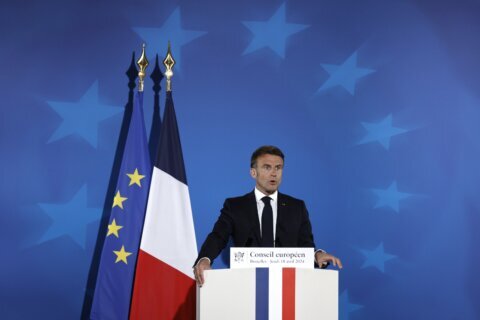LONDON (AP) — Prime Minister Liz Truss took office last month promising to reenergize the British economy and put the nation on a path to “long-term success.” Instead, her tenure so far has been marred by turmoil as mortgage rates soared, the pound fell to record lows and chaos in bond markets threatened the country’s financial stability.
While Truss came to power at a difficult time — facing a cost-of-living crisis, the war in Ukraine and the lingering effects of the COVID-19 pandemic — her decision to announce 105 billion pounds ($116 billion) of tax cuts and spending increases without providing details on how she would pay for it spooked markets concerned about soaring public debt.
That undermined confidence in the government’s ability to pay its bills and raised questions about the economic credentials of a new prime minister who took office after a deeply divisive contest for leadership of the governing Conservative Party.
Here’s a look at what triggered the turmoil on British financial markets:
HOW DID LIZ TRUSS BECOME PRIME MINISTER?
Truss’ predecessor, Boris Johnson, was forced out of office after a series of scandals culminated with more than 50 Cabinet ministers and lower-level officials resigning from his government. That triggered an internal contest to lead the Conservative Party.
The election divided the Conservatives. Truss was the second choice of party lawmakers, behind former Treasury chief Rishi Sunak, but she won 57% of votes among party members, making her party leader and prime minister.
While Truss inherited the large majority in Parliament that the Conservatives won in 2019, she didn’t win her own mandate by leading the party in a general election.
WHAT IS THE GOVERNMENT’S ECONOMIC PLAN?
Treasury chief Kwasi Kwarteng on Sept. 23 announced plans to cut taxes by 45 billion pounds, while reducing red tape and promoting investment to spur economic growth. He also said the government would borrow at least 60 billion pounds to finance a plan to cap high energy prices for households and businesses that have triggered a cost-of-living crisis.
The government’s goal is to boost economic growth to an average of 2.5% annually, which it says will increase tax revenue and provide more money for public services.
WHY DID THAT TRIGGER INVESTOR CONCERN?
Kwarteng didn’t provide any independent analysis of whether the government’s goal was likely to be achieved or its impact on public finances. That triggered speculation that the government would have to finance the package with borrowing, pushing public debt to unsustainable levels.
In addition, the government’s decision to pump billions into the economy is likely to fuel further price increases, meaning the Bank of England may need to raise interest rates even higher to control inflation that is already running at a near 40-year high of 9.9%.
In response to these concerns, Kwarteng says he will release an analysis from the independent Office for Budget Responsibility at the end of October — earlier than previously planned — alongside a “medium-term fiscal plan” on how the tax cuts will be paid for.
HOW DID FINANCIAL MARKETS REACT?
The pound fell to a record low against the U.S. dollar, dropping as low as $1.038 on Sept. 26, as investors bet against the British currency. The pound traded for around $1.108 on Wednesday, still down about 2% since Kwarteng introduced the economic plan.
Yields on government bonds — the return investors demand to hold government debt — soared amid growing concern about the stability of public finances. That makes government borrowing costs more expensive. The yield on 10-year government bonds rose to 4.53% on Wednesday from 3.37% on Sept. 22.
The Bank of England on Sept. 28 announced a rare emergency intervention to buy up billions of pounds of long-term government bonds to stabilize the market and protect pension funds.
The funds were forced to sell bonds to head off worries over their liquidity, which threatened severe losses to workers’ retirement funds.
“Dysfunction in this market, and the prospect of self-reinforcing ‘fire sale’ dynamics pose a material risk to U.K. financial stability,” the bank said when it expanded the program Tuesday.
WHERE DO WE GO FROM HERE?
Financial markets are likely to remain volatile until the government releases its full economic plan, including the independent analysis of the impact on public finances.
Investors are looking for assurances that the government is committed to reducing debt as a percentage of gross domestic product once Britain gets past the current economic crisis.
Bank of England Gov. Andrew Bailey said Tuesday that its intervention to stabilize the bond market would end Friday as scheduled. But investors worry what’s next.
“It is a very difficult line to maintain that interventions are currently absolutely necessary to maintain market functioning in a core UK asset market, and that those interventions can only extend until Friday this week and no further,” said Luke Bartholomew, a senior economist at abrdn. “Having to reverse course after such an explicit statement of intent is likely to end up further damaging the Bank’s standing with markets and efficacy of its communication.”
In the meantime, the government is likely to face political pressure to reverse some of its more controversial proposals. Truss last week canceled plans to cut taxes for high earners amid a backlash from members of her own party.
No matter how she responds now, the disarray surrounding the economic plan has weakened Truss’s authority as prime minister. That creates uncertainty about her future that is likely to make investors uneasy even if she gets past this crisis.
Copyright © 2024 The Associated Press. All rights reserved. This material may not be published, broadcast, written or redistributed.







